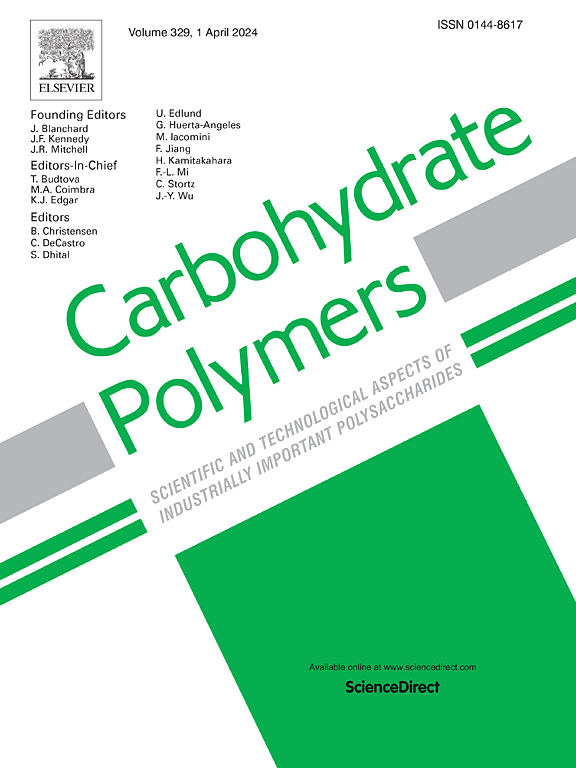直链淀粉/支链淀粉与不同结构多酚的相互作用
IF 12.5
1区 化学
Q1 CHEMISTRY, APPLIED
引用次数: 0
摘要
本研究旨在通过实验与计算相结合的方法,系统阐明四种多酚类物质与直链淀粉/支链淀粉的相互作用机制。儿茶素(CC)和表没食子儿茶素没食子酸酯(EGCG)对直链淀粉/支链淀粉的结合能力最强,其次是花青素-3- o -葡萄糖苷(C3G),阿魏酸(FA)的结合能力最低。多酚诱导淀粉链聚集,增大淀粉颗粒尺寸(直链淀粉:152.1→157.78 nm;支链淀粉:96.2→95.4 nm),缩短了近程有序结构(lcm -拉曼光谱480 cm−1波段半最大值全宽度增加;FTIR吸光度比R1050/1022和R995/1022分别下降13.43%和7.35%)。分子动力学(MD)模拟表明,多酚破坏螺旋结构,并作为“桥梁”交联相邻的淀粉链。多酚的羟基和淀粉葡萄糖残基的C6位置驱动氢键结合;结合能力随着羟基数目的增加而增加(FA <;CC & lt;EGCG)。相比之下,C3G作为一种黄离子,主要通过静电力相互作用。本研究创新性地结合了实验表征和MD方法,提供了淀粉-多酚相互作用的原子性见解,有助于淀粉基传递系统的设计。本文章由计算机程序翻译,如有差异,请以英文原文为准。

Interaction between amylose/amylopectin and polyphenols of different structures
This study aims to systematically elucidate the interaction mechanism between four polyphenols and amylose/amylopectin through integrated experimental and computational approaches. Catechin (CC) and epigallocatechin gallate (EGCG) exhibit excellent binding capacities for amylose/amylopectin, followed by cyanidin-3-O-glucoside (C3G), while ferulic acid (FA) exhibits the lowest binding capacity. Polyphenols induce starch chain aggregation, increasing particle sizes (amylose: 152.1 → 157.78 nm; amylopectin: 96.2 → 95.4 nm) and reducing the short-range ordered structure (full width at half-maximum of the 480 cm−1 band in LCM-Raman spectra increases; FTIR absorbance ratios R1050/1022 and R995/1022 decrease by 13.43 % and 7.35 %, respectively). Molecular dynamics (MD) simulations reveal that polyphenols disrupt helical structures and act as the “bridges” crosslink adjacent starch chains. Hydroxyl groups of polyphenols and the C6 position of starch glucose residues drive binding by hydrogen bond; the binding capacity increases with hydroxyl group number (FA < CC < EGCG). In contrast, C3G, as a flavylium cation, primarily interacts via electrostatic forces. This study innovatively combines experimental characterization and MD approaches to provide atomistic insights into starch-polyphenol interactions, aiding the design of starch-based delivery systems.
求助全文
通过发布文献求助,成功后即可免费获取论文全文。
去求助
来源期刊

Carbohydrate Polymers
化学-高分子科学
CiteScore
22.40
自引率
8.00%
发文量
1286
审稿时长
47 days
期刊介绍:
Carbohydrate Polymers stands as a prominent journal in the glycoscience field, dedicated to exploring and harnessing the potential of polysaccharides with applications spanning bioenergy, bioplastics, biomaterials, biorefining, chemistry, drug delivery, food, health, nanotechnology, packaging, paper, pharmaceuticals, medicine, oil recovery, textiles, tissue engineering, wood, and various aspects of glycoscience.
The journal emphasizes the central role of well-characterized carbohydrate polymers, highlighting their significance as the primary focus rather than a peripheral topic. Each paper must prominently feature at least one named carbohydrate polymer, evident in both citation and title, with a commitment to innovative research that advances scientific knowledge.
 求助内容:
求助内容: 应助结果提醒方式:
应助结果提醒方式:


